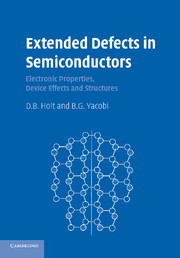Book contents
- Frontmatter
- Contents
- Preface
- 1 Semiconducting materials
- 2 An introduction to extended defects
- 3 Characterization of extended defects in semiconductors
- 4 Core structures and mechanical effects of extended defects specific to semiconductors
- 5 The electrical, optical and device effects of dislocations and grain boundaries
- 6 Point defect materials problems
- Index
- References
3 - Characterization of extended defects in semiconductors
Published online by Cambridge University Press: 10 September 2009
- Frontmatter
- Contents
- Preface
- 1 Semiconducting materials
- 2 An introduction to extended defects
- 3 Characterization of extended defects in semiconductors
- 4 Core structures and mechanical effects of extended defects specific to semiconductors
- 5 The electrical, optical and device effects of dislocations and grain boundaries
- 6 Point defect materials problems
- Index
- References
Summary
Introduction
This chapter outlines the principles, advantages and limitations of the methods in use for the characterization of extended defects and should enable the reader to appreciate the experimental results presented. For additional accounts see Brundle et al. 1992, Yacobi et al. 1994, Schroder 1998, and Runyan and Shaffner 1998.
Characterization methods can be classified as (i) either surface or bulk techniques, as (ii) either destructive or non-destructive methods, and as (iii) either requiring the application of contacts or not. We have excluded the free surface from consideration on the grounds that, like point defects, its study constitutes a large specialized field already covered by many publications. We therefore also omit surface microscopy and analysis techniques here. Generally, non-destructive techniques are preferred as are contactless ones. However, in practice neither is a very important factor as generally one or a few specimens can be sacrificed for destructive examination and contacts can usually be applied.
Characterization techniques are essential for failure analysis and quality control of semiconductor materials and devices. Often failure modes are associated with manufacturing process-induced defects or with defect-dependent device degradation in service.
Electrical measurements for the analysis of a wide range of semiconductor transport properties such as, for example, resistivity (conductivity), Hall effect and capacitance-voltage measurements are made on whole bulk specimens and devices. The net influence on these properties of all the defects present then appears in the results.
- Type
- Chapter
- Information
- Extended Defects in SemiconductorsElectronic Properties, Device Effects and Structures, pp. 122 - 162Publisher: Cambridge University PressPrint publication year: 2007
References
- 1
- Cited by



